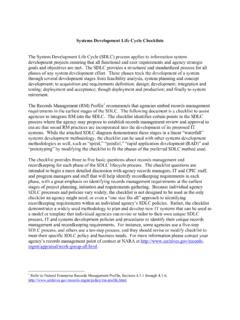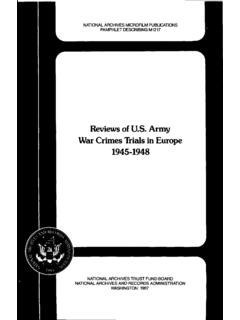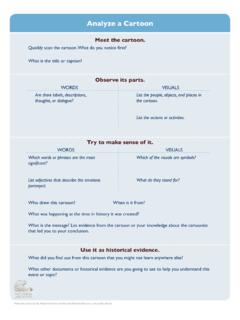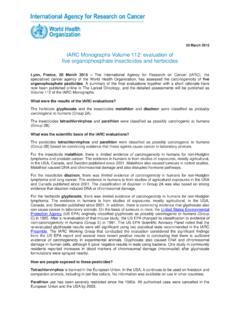Transcription of *NARA Briefing #312 - Archives
1 classified InformationNondisclosure Agreement(Standard Form 312) Briefing BookletThis booklet provides you with information about the ClassifiedInformation Nondisclosure Agreement, also known as the SF 312. It includes a brief discussion of the background and purpose of the SF312; the text of pertinent legislative and executive authorities; a series ofquestions and answers on its implementation; and acopy of the SF 312. Each organiza-tion may wish to supplement thisbooklet with additional guidancethat addresses problems or cir-cumstances unique to booklet should be available in the offices of those persons who briefindividuals about the SF 312, , security managers, security educa-tion specialists, or supervisors. Further, all persons who are asked to exe-cute the SF 312, or have executed it or its predecessors, the SF 189 or SF189-A, should have the opportunity to receive or borrow a copy additional guidance, please contact your security manager, super-visor or legal counsel within your organization.
2 If questions concerningthe SF 312 cannot be answered within your organization, please bringthem to the attention of ISOO, 700 Pennsylvania Avenue, ,Washington, 20408, telephone number (202) 219-5250. Spring 2001 Reprint 1 TABLE OF CONTENTSB ackground and Purpose ..5 Legislative and Executive Authorities Cited in the SF 312 ..7 Questions and Answers on Implementation of the SF 312 ..61 3 BACKGROUND AND PURPOSEAs an employee of the Federal Government or one of its contractors, licensees, orgrantees who occupies a position which requires access to classified information,you have been the subject of a personnel security investigation. The purpose ofthis investigation was to determine your trustworthiness for access to classifiedinformation. When the investigation was completed, your employing or sponsor-ing department or agency granted you a security clearance based upon a favorabledetermination of the investigation results.
3 By being granted a security clearance,you have met the first of three requirements necessary to have access to second requirement that you must fulfill is to sign a classified InformationNondisclosure Agreement, the SF 312. The President first established this require-ment in a directive that states: All persons with authorized access to classifiedinformation shall be required to sign a nondisclosure agreement as a condition ofaccess. This requirement is reiterated in the executive order on classified nationalsecurity information. The SF 312 is a contractual agreement between the and you, a cleared employee, in which you agree never to discloseclassified information to an unauthorized person. Its primary purpose is to informyou of (1) the trust that is placed in you by providing you access to classified infor-mation; (2) your responsibilities to protect that information from unauthorized dis-closure; and (3) the consequences that may result from your failure to meet thoseresponsibilities.
4 Additionally, by establishing the nature of this trust, your respon-sibilities, and the potential consequences of noncompliance in the context of a con-tractual agreement, if you violate that trust, the United States will be better able toprevent an unauthorized disclosure or to discipline you for such a disclosure byinitiating a civil or administrative third and final requirement for access to classified information is the need-to-know; that is, you must have a need to know the information in order to performyour official duties. The holder of classified information to which you seek accessis responsible for confirming your identity, your clearance, and your need-to-know. As a holder of classified information, you are responsible for making thesesame determinations with respect to any individual to whom you may disclose it.
5 5 As a cleared employee you should receive, according to paragraph No. 2 of the SF312, a security indoctrination Briefing concerning the nature and protection ofclassified information, including procedures to be followed in ascertaining whetherother persons to whom you contemplate disclosing this information have beenapproved for access to it .. After you receive such a Briefing , you should havea basic understanding of the following: What is classified information? How do you protect it? Who may have access to it? How does the classification system function?A variety of educational materials are available that provide answers to these ques-tions. Several training methods may be used to convey this information, includingbriefings, interactive videos, and dissemination of instructional materials.
6 Contactyour security manager for more information. 6 LEGISLATIVE AND EXECUTIVE AUTHORITIES 7 9 Title 18, United States Code 641. Public money, property or recordsWhoever embezzles, steals, purloins, or knowingly converts his use or the use ofanother, or without authority, sells, conveys or disposes of any record, voucher,money, or thing of value of the United States or of any department or agency there-of, or any property made or being made under contract for the United States or anydepartment or agency thereof; orWhoever receives, conceals, or retains the same with intent to convert it to his useor gain, knowing it to have been embezzled, stolen, purloined or converted Shall be fined not more than $10,000 or imprisoned not more than ten years, orboth; but if the value of such property does not exceed the sum of $100, he shallbe fined not more than $1,000 or imprisoned not more than one year, or word value means face, par, or market value, or cost price, either wholesaleor retail, whichever is 18, United States Code 793.
7 Gathering, transmitting or losing defense information(a) Whoever, for the purpose of obtaining information respecting the nationaldefense with intent or reason to believe that the information is to be used to theinjury of the United States, or to the advantage of any foreign nation, goes upon,enters, flies over, or otherwise obtains information concerning any vessel, aircraft,work of defense, navy yard, naval station, submarine base, fueling station, fort, bat-tery, torpedo station, dockyard, canal, railroad, arsenal, camp, factory, mine, tele-graph, telephone, wireless, or signal station, building, office, research laboratory orstation or other place connected with the national defense owned or constructed,or in progress of construction by the United States or under the control of theUnited States.
8 Or of any of its officers, departments, or agencies, or within theexclusive jurisdiction of the United States, or any place in which any vessel, air-craft, arms, munitions, or other materials or instruments for use in time of war arebeing made, prepared, repaired, stored, or are the subject of research or develop-ment, under any contract or agreement with the United States, or any departmentor agency thereof, or with any person on behalf of the United States, or otherwiseon behalf of the United States, or any prohibited place so designated by thePresident by proclamation in time of war or in case of national emergency in whichanything for the use of the Army, Navy, or Air Force is being prepared or con-structed or stored, information as to which prohibited place the President has deter-mined would be prejudicial to the national defense; or(b) Whoever, for the purpose aforesaid, and with like intent or reason to believe,copies, takes, makes, or obtains, or attempts to copy, take, make, or obtain, anysketch, photograph, photographic negative, blueprint, plan, map, model, instru-ment, appliance, document, writing, or note of anything connected with the nation-al defense.
9 Or(c) Whoever, for the purpose aforesaid, receives or obtains or agrees or attemptsto receive or obtain from any person, or from any source whatever, any document,writing, code book, signal book, sketch, photograph, photographic negative, blue-print, plan, map, model, instrument, appliance, or note, of anything connected withthe national defense, knowing or having reason to believe, at the time he receivesor obtains, or agrees or attempts to receive or obtain it, that it has been or will beobtained, taken, made, or disposed of by any person contrary to the provisions ofthis chapter; or 10 (d) Whoever, lawfully having possession of, access to, control over, or beingentrusted with any document, writing, code book, signal book, sketch, photograph,photographic negative, blueprint, plan, map, model, instrument, appliance, or noterelating to the national defense, or information relating to the national defensewhich information the possessor has reason to believe could be used to the injuryof the United States or to the advantage of any foreign nation, willfully communi-cates, delivers, transmits or causes to be communicated, delivered, or transmittedor attempts to communicate, deliver, transmit or cause to be communicated, deliv-ered or transmitted the same to any person not entitled to receive it.
10 Or willfullyretains the same and fails to deliver it on demand to the officer or employee of theUnited States entitled to receive it; or(e) Whoever, having unauthorized possession of, access to, or control over anydocument, writing, code book, signal book, sketch, photograph, photographic neg-ative, blueprint, plan, map, model, instrument, appliance, or note relating to thenational defense, or information relating to the national defense which informationthe possessor has reason to believe could be used to the injury of the United Statesor to the advantage of any foreign nation, willfully communicates, delivers, trans-mits or causes to be communicated, delivered, or transmitted, or attempts to com-municate, deliver, transmit or cause to be communicated, delivered, or transmittedthe same to any person not entitled to receive it.














